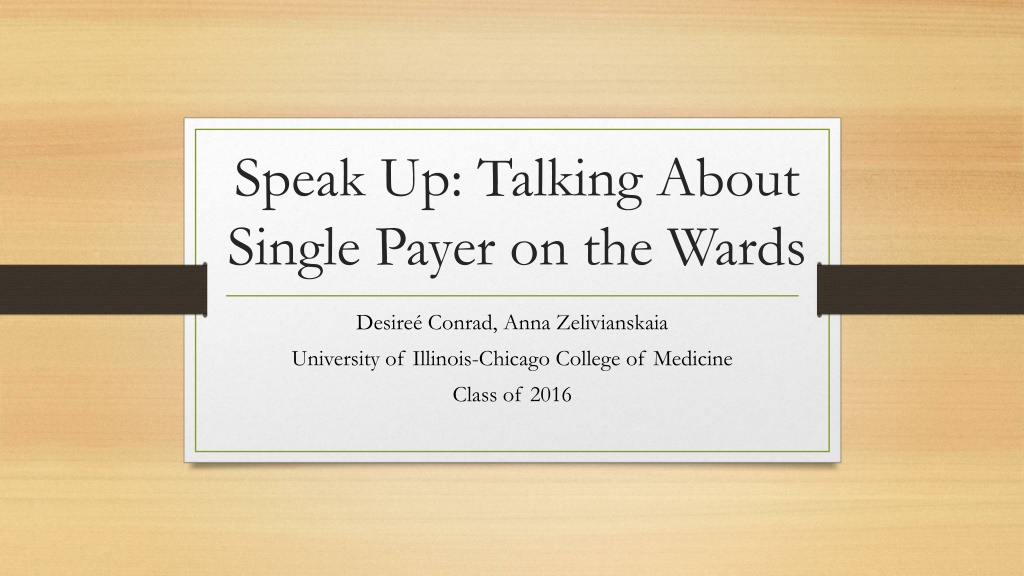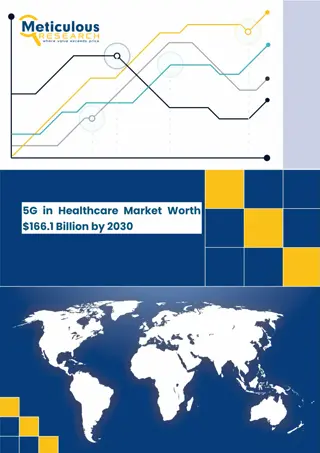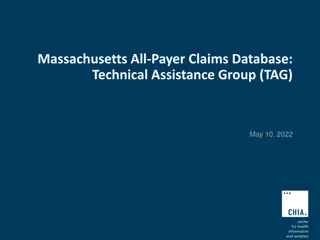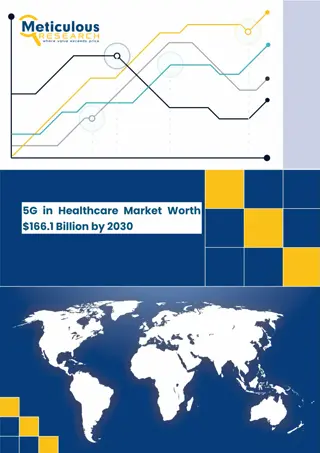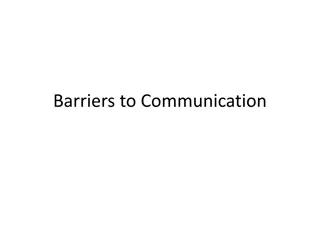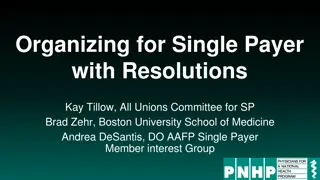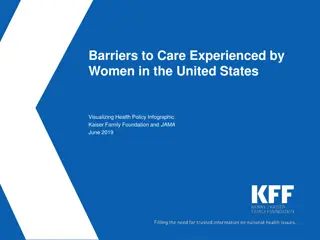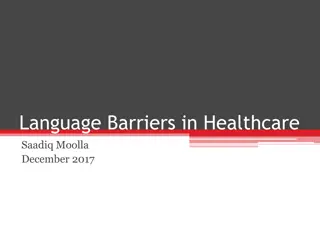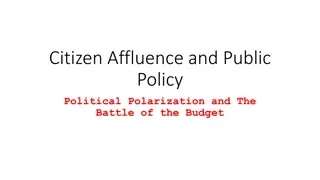Exploring Single Payer Healthcare: Opportunities and Barriers
Understanding the concept of single-payer healthcare, its potential benefits, and challenges in implementation. Discusses the disparities in healthcare access and outcomes, highlighting the need for a reevaluation of the current system in the U.S.
Download Presentation

Please find below an Image/Link to download the presentation.
The content on the website is provided AS IS for your information and personal use only. It may not be sold, licensed, or shared on other websites without obtaining consent from the author. Download presentation by click this link. If you encounter any issues during the download, it is possible that the publisher has removed the file from their server.
E N D
Presentation Transcript
Speak Up: Talking About Single Payer on the Wards Desire Conrad, Anna Zelivianskaia University of Illinois-Chicago College of Medicine Class of 2016
What is single payer? SINGLE-PAYER: A way of financing healthcare for the entire population in a geographic/political entity. And financing is different from delivering healthcare. A publicly financed system can be delivered two different ways: Private care delivery: Traditional Medicare, FFS Medicaid, Canada Public care delivery: VA, Military health system, Indian Health Service, Great Britain Either option eliminates private health insurance except for supplemental benefits not covered in single-payer program.
Opportunities and Barriers to Promoting Single Payer Opportunities: physicians commenting on problems with U.S. healthcare, seeing un- or underinsured patients in clinic, talking about the costs of various medical tests Barriers: I m a lowly medical student and there s a hospital hierarchy, I don t know where to start, I don t want to seem like I m advertising an organization when I should be focused on patient care
Learn the Facts The U.S. spends approximately 2x as much per capita on healthcare spending compared to other developed nations (exact comparison figures vary by country) Health care costs make up 17.7% of the U.S. GDP while the average developed nation spends 9.3% Yet we have the lowest life expectancy at 78.7 years compared to UK, Canada, France, Italy, Germany, and Sweden We rank 26thout of 36 member countries in life expectancy Note: Data are for 2011 or most recent year available Source: OECD report, 2013
Case Study: Chicago Geography of Disparity High breast cancer mortality, African American communities High breast cancer mortality, Non-African American communities Hospitals with American College of Surgeons Approved Cancer Programs Age-Adjusted Female Breast Cancer Mortality for Chicago, Per 100,000 Population. 2000-2005 Prepared by The Sinai Urban Health Institute Prepared by The Sinai Urban Health Institute Thanks to Ed Thanks to Ed Weisbart Weisbart, MD and David Ansell, MD , MD and David Ansell, MD
Bottom line: MAJOR HEALTH DISPARITIES STILL EXIST SO WHAT ARE WE PAYING SO MUCH FOR ?
Growth of Physicians vs Administrators 3000% 2500% Growth Since 1970 2000% 1500% 1000% 500% 0 1970 1980 1990 2000 2010 Physicians Administrators Data updated through 2013 Source: Bureau of Labor Statistics; NCHS; Himmelstein/Woolhandler analysis of CPS
Single-Payer Savings Administration (~16%): focused on assuring care and payment, not avoiding risk Insurance Administration Managed Care Administration No: Care managed by doctors & hospitals, not health plans No complex financial incentives and risk adjustment Simplified data for QI No distortion of data due to pay- for-documentation Much less fraud and abuse Exorbitant exec salaries, marketing, lobbying, profit Underwriting, insurance reserves, broker fees, exchange fees Eligibility determination, narrow networks For entire health care system: ~ 30-40% savings *Slide taken from presentation The Business Case for Single Payer by Steve Kemble, M.D., March 11, 2014 Available at www.pnhp.org
Its Good for Business! Reduces direct costs: no health insurance administrative costs or retiree benefits for businesses bulk purchasing negotiated prices Reduces risk: Access to healthcare for all mitigates the outliers who require more costly care Better access to outpatient care More incentives for preventative medicine *Slide adapted from presentation The Business Case for Single Payer by Steve Kemble, M.D., March 11, 2014 Available at www.pnhp.org
Common Arguments Against Single Payer Cost Care It will not save money. It will decrease physician salary. Why should I pay for someone else s care? It stifles the free market and is against capitalism. Quality of care will suffer. It will ration care. It will take medical decisions away from physicians and patients. It will hamper medical research and technological innovation.
Counter Arguments for Cost It will not save money. Decreased administrative cost, bulk purchasing, negotiated pricing. IOM estimates $500B lost annually due to diminished productivity of an uninsured population. It will decrease physician salary. When compared to other industrialized nations, average US physician earning is more. However, this is not a fair comparison when less than the physicians are specialists in other nations. In US, pay for primary care pay lags significantly behind specialty care. Furthermore, physicians under single payer systems do not have as high of cost for malpractice nor as high of education debt burden. The average physician salary in Canada is $307, 482. Why should I pay for someone else s care? You already pay for the uninsured. Unfortunately, it is at a much higher cost when the uninsured are seeking urgent care. Urgent care costs are significantly higher than routine primary care visits. It stifles the free market and is against capitalism. In more than 90% of measured areas in the US, competition is restricted to less than three private insurers. An unrestricted free market would price many people out of insurance.
Counter Arguments for Care Quality of care will suffer. Quality of care will improve due standardization of quality improvement initiatives and EBM. The uninsured delay care for chronic conditions leading to poorer outcomes and more preventable deaths. It will ration care. Single payer system would lead to more equitable and efficient distribution of scarce health care resources and services. It will take medical decisions away from physicians and patients. Under a singly payer system, health care services are privately delivered by physicians but publicly financed by the government. This means clinical decisions are still made by the provider and the patient. It will also increase patient autonomy by eliminating networks and allowing patients to choose their physicians. It will hamper medical research and technological innovation. Most medical research is currently funded by NIH (a government agency). Furthermore, the inappropriate use of technology will be reduced leading to more practice of evidenced-based medicine.
